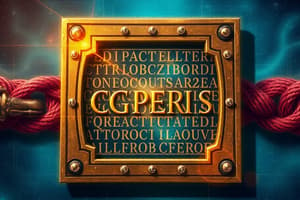Podcast
Questions and Answers
What is the primary feature of the Caesar cipher?
What is the primary feature of the Caesar cipher?
- It employs a rotating key for encryption.
- It encrypts messages by reversing the order of letters.
- It utilizes complex mathematical algorithms.
- It involves shifting each letter of the alphabet a fixed number of positions. (correct)
What happens to the letter 'Z' when it is shifted by 3 positions?
What happens to the letter 'Z' when it is shifted by 3 positions?
- It becomes 'F'.
- It remains 'Z'.
- It becomes 'A'.
- It becomes 'C'. (correct)
Which of the following is true about the decryption process of the Caesar cipher?
Which of the following is true about the decryption process of the Caesar cipher?
- It uses a random key for every letter.
- It requires additional information not included in the ciphertext.
- It can only be performed using sophisticated software.
- It involves a negative shift of the key value. (correct)
What makes the Caesar cipher easy to decipher?
What makes the Caesar cipher easy to decipher?
Which letters are the most frequent in the English language that could affect frequency analysis of the Caesar cipher?
Which letters are the most frequent in the English language that could affect frequency analysis of the Caesar cipher?
Why is the Caesar cipher considered insecure by modern standards?
Why is the Caesar cipher considered insecure by modern standards?
How does a negative shift affect the letters in the Caesar cipher?
How does a negative shift affect the letters in the Caesar cipher?
Which phrase best captures a limitation of the Caesar cipher?
Which phrase best captures a limitation of the Caesar cipher?
Flashcards
Caesar cipher
Caesar cipher
A simple substitution cipher that shifts each letter of the plaintext message a fixed number of positions down the alphabet.
Caesar cipher key
Caesar cipher key
The number of positions to shift each letter in a Caesar cipher.
Caesar cipher encryption
Caesar cipher encryption
The process of converting plaintext into ciphertext using a Caesar cipher.
Caesar cipher decryption
Caesar cipher decryption
Signup and view all the flashcards
Frequency analysis
Frequency analysis
Signup and view all the flashcards
Brute-force attack
Brute-force attack
Signup and view all the flashcards
Small key space
Small key space
Signup and view all the flashcards
Modern cryptography
Modern cryptography
Signup and view all the flashcards
Study Notes
Caesar Cipher Overview
- The Caesar cipher is a simple substitution cipher.
- It shifts each letter of the plaintext a fixed number of positions down the alphabet.
- The key is the number of positions each letter is shifted.
- A shift of 3 replaces 'A' with 'D', 'B' with 'E', etc.
- The alphabet repeats (e.g., 'Z' shifted by 3 becomes 'C').
- The same shift is applied to every letter.
- Easily deciphered using frequency analysis.
- Named after Julius Caesar, reportedly used for military communication.
- A very simple and easily broken encryption method.
- Modern cryptography uses far more complex ciphers.
- Security depends entirely on the key (the shift value).
Variations
- Negative shifts are possible, shifting letters to the left.
- Encryption formula: (plaintext letter position + key) modulo 26.
- Modulo 26 gives the new position in the alphabet.
- Decryption formula: (ciphertext letter position - key) modulo 26.
Example
- Key = 3
- Plaintext: HELLO
- Ciphertext: KHOOR
Cryptanalysis
- Frequency analysis is used to break the Caesar cipher.
- Letter frequencies in English are not uniform.
- The most common letters are E, T, A, O, I, N, S, H, R, D.
- Observing ciphertext letter frequencies helps infer the shift value.
- Compare the ciphertext's frequency distribution to the known frequencies of English letters.
- Identifying the most frequent ciphertext letter provides a key clue for the shift.
Limitations
- The Caesar cipher is extremely insecure today.
- Highly vulnerable to brute-force attacks (trying all possible shifts).
- Only 26 possible keys (in a standard alphabet).
- Too simple for modern secure communication.
Studying That Suits You
Use AI to generate personalized quizzes and flashcards to suit your learning preferences.




